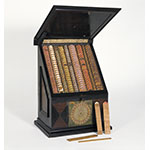Instrument composed of a veneered wooden chest with a hinged lid. On the lid and the front side are two squares of painted copper with rotatable discs. On the back, a small hinged shutter conceals a small empty chamber. The inside of the chest is divided into nine compartments, one for each of the following subjects: Arithmetic, Geometry, Art of fortifications, Chronology, Horography, Astronomy, Astrology, Steganography, and Music. Each compartment contains twenty-four small rods ending in a colored triangular tip. On each of the nine series of twenty-four small rods are inscribed definitions and information on the corresponding subject. At least one rod in each of the nine compartments has a black tip and constitutes the application table, which gives the rule for proper use. To multiply 74 x 8, for example, one removes the black-tipped rod from the Arithmetic compartment and places it next to the rods carrying the numbers 7 and 4 at the top. The eighth line on the black-tipped rod gives the desired product. This chest, was invented by Athanasius Kircher, who called it Organum Mathematicum or Cista mathematica or Arca. Described by Gaspar Schott in Organum Mathematicum libris IX explicatum (Herbipoli [Würzburg], 1668), it is a sort of portable encyclopedia, or comprehensive system for the classification of knowledge.











